Comprehensive Literature Review: Capital Budgeting Techniques
VerifiedAdded on 2019/09/22
|6
|1414
|170
Literature Review
AI Summary
This literature review explores the concept of capital budgeting as a crucial process for investment decision-making and capital expenditure planning. It defines capital budgeting, highlighting its significance in long-term investments and risk assessment, referencing key sources like Brigham et al. (2013) and Bierman et al. (2012). The review examines the impact of capital market variables, such as agency costs and interest rates, on corporate governance and capital budgeting outcomes. It discusses the two primary sources of capital: equity and debt, and emphasizes the objective of maximizing shareholder wealth through strategic investments. Various capital budgeting methods, including discounting and non-discounting cash flow techniques, are analyzed, with a focus on methods like Net Present Value (NPV), Internal Rate of Return (IRR), and payback period. The review acknowledges the limitations of certain methods and highlights the importance of selecting appropriate techniques for evaluating investment projects and making sound financial decisions. The review concludes by acknowledging a gap between financial theories and practical project appraisal decisions.

Literature Review of Capital Budgeting
Student Name:
Course work:
University:
Student Name:
Course work:
University:
Paraphrase This Document
Need a fresh take? Get an instant paraphrase of this document with our AI Paraphraser
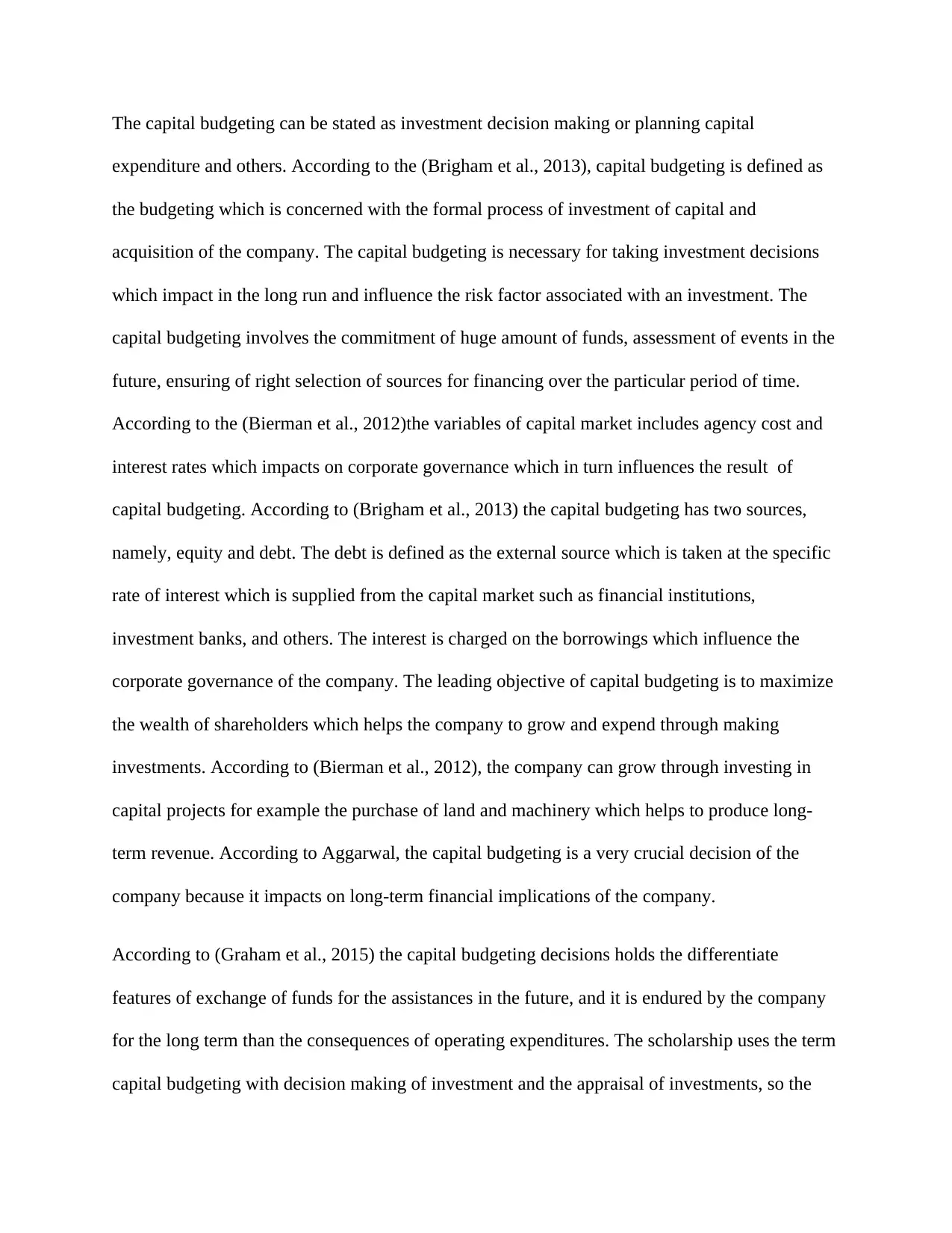
The capital budgeting can be stated as investment decision making or planning capital
expenditure and others. According to the (Brigham et al., 2013), capital budgeting is defined as
the budgeting which is concerned with the formal process of investment of capital and
acquisition of the company. The capital budgeting is necessary for taking investment decisions
which impact in the long run and influence the risk factor associated with an investment. The
capital budgeting involves the commitment of huge amount of funds, assessment of events in the
future, ensuring of right selection of sources for financing over the particular period of time.
According to the (Bierman et al., 2012)the variables of capital market includes agency cost and
interest rates which impacts on corporate governance which in turn influences the result of
capital budgeting. According to (Brigham et al., 2013) the capital budgeting has two sources,
namely, equity and debt. The debt is defined as the external source which is taken at the specific
rate of interest which is supplied from the capital market such as financial institutions,
investment banks, and others. The interest is charged on the borrowings which influence the
corporate governance of the company. The leading objective of capital budgeting is to maximize
the wealth of shareholders which helps the company to grow and expend through making
investments. According to (Bierman et al., 2012), the company can grow through investing in
capital projects for example the purchase of land and machinery which helps to produce long-
term revenue. According to Aggarwal, the capital budgeting is a very crucial decision of the
company because it impacts on long-term financial implications of the company.
According to (Graham et al., 2015) the capital budgeting decisions holds the differentiate
features of exchange of funds for the assistances in the future, and it is endured by the company
for the long term than the consequences of operating expenditures. The scholarship uses the term
capital budgeting with decision making of investment and the appraisal of investments, so the
expenditure and others. According to the (Brigham et al., 2013), capital budgeting is defined as
the budgeting which is concerned with the formal process of investment of capital and
acquisition of the company. The capital budgeting is necessary for taking investment decisions
which impact in the long run and influence the risk factor associated with an investment. The
capital budgeting involves the commitment of huge amount of funds, assessment of events in the
future, ensuring of right selection of sources for financing over the particular period of time.
According to the (Bierman et al., 2012)the variables of capital market includes agency cost and
interest rates which impacts on corporate governance which in turn influences the result of
capital budgeting. According to (Brigham et al., 2013) the capital budgeting has two sources,
namely, equity and debt. The debt is defined as the external source which is taken at the specific
rate of interest which is supplied from the capital market such as financial institutions,
investment banks, and others. The interest is charged on the borrowings which influence the
corporate governance of the company. The leading objective of capital budgeting is to maximize
the wealth of shareholders which helps the company to grow and expend through making
investments. According to (Bierman et al., 2012), the company can grow through investing in
capital projects for example the purchase of land and machinery which helps to produce long-
term revenue. According to Aggarwal, the capital budgeting is a very crucial decision of the
company because it impacts on long-term financial implications of the company.
According to (Graham et al., 2015) the capital budgeting decisions holds the differentiate
features of exchange of funds for the assistances in the future, and it is endured by the company
for the long term than the consequences of operating expenditures. The scholarship uses the term
capital budgeting with decision making of investment and the appraisal of investments, so the
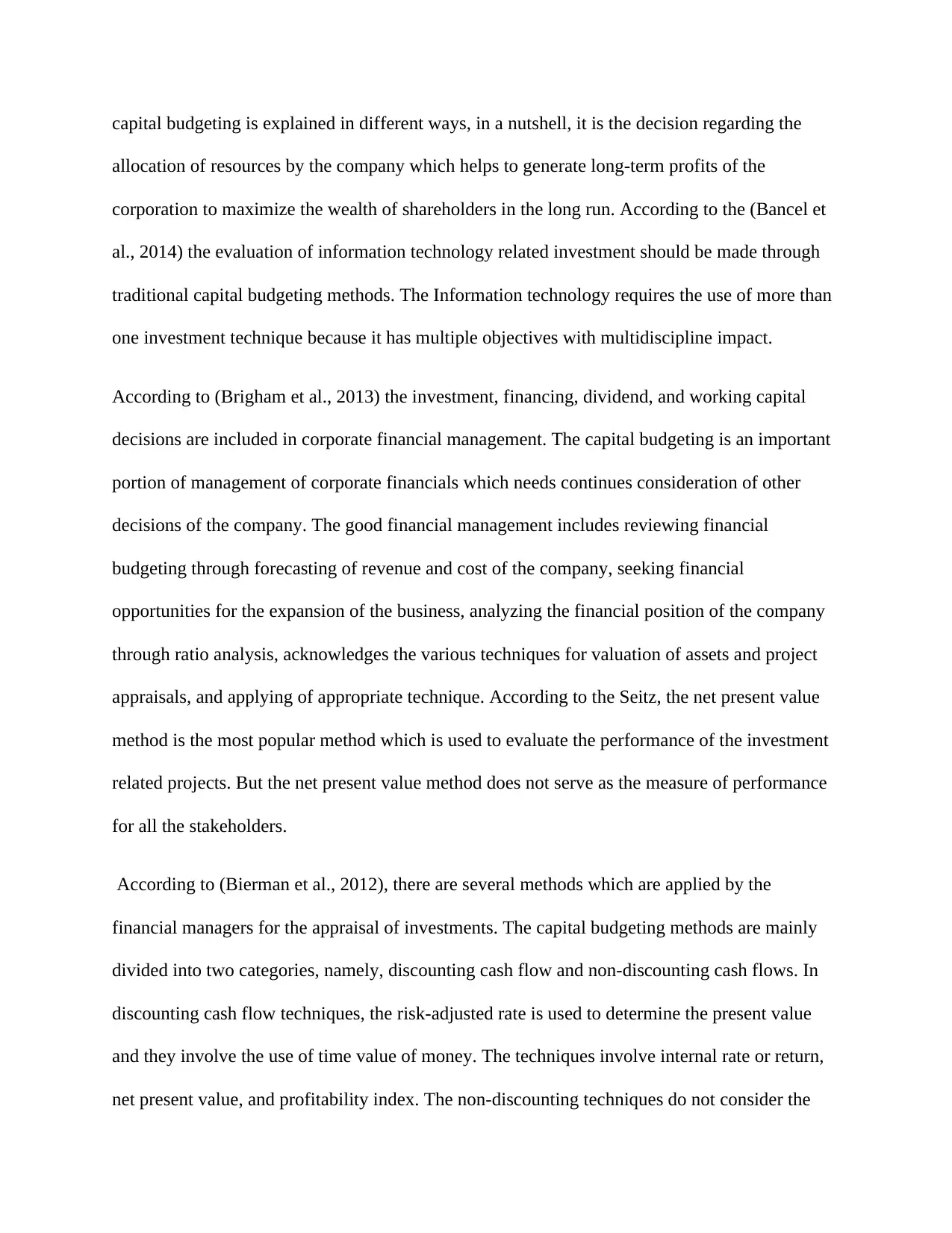
capital budgeting is explained in different ways, in a nutshell, it is the decision regarding the
allocation of resources by the company which helps to generate long-term profits of the
corporation to maximize the wealth of shareholders in the long run. According to the (Bancel et
al., 2014) the evaluation of information technology related investment should be made through
traditional capital budgeting methods. The Information technology requires the use of more than
one investment technique because it has multiple objectives with multidiscipline impact.
According to (Brigham et al., 2013) the investment, financing, dividend, and working capital
decisions are included in corporate financial management. The capital budgeting is an important
portion of management of corporate financials which needs continues consideration of other
decisions of the company. The good financial management includes reviewing financial
budgeting through forecasting of revenue and cost of the company, seeking financial
opportunities for the expansion of the business, analyzing the financial position of the company
through ratio analysis, acknowledges the various techniques for valuation of assets and project
appraisals, and applying of appropriate technique. According to the Seitz, the net present value
method is the most popular method which is used to evaluate the performance of the investment
related projects. But the net present value method does not serve as the measure of performance
for all the stakeholders.
According to (Bierman et al., 2012), there are several methods which are applied by the
financial managers for the appraisal of investments. The capital budgeting methods are mainly
divided into two categories, namely, discounting cash flow and non-discounting cash flows. In
discounting cash flow techniques, the risk-adjusted rate is used to determine the present value
and they involve the use of time value of money. The techniques involve internal rate or return,
net present value, and profitability index. The non-discounting techniques do not consider the
allocation of resources by the company which helps to generate long-term profits of the
corporation to maximize the wealth of shareholders in the long run. According to the (Bancel et
al., 2014) the evaluation of information technology related investment should be made through
traditional capital budgeting methods. The Information technology requires the use of more than
one investment technique because it has multiple objectives with multidiscipline impact.
According to (Brigham et al., 2013) the investment, financing, dividend, and working capital
decisions are included in corporate financial management. The capital budgeting is an important
portion of management of corporate financials which needs continues consideration of other
decisions of the company. The good financial management includes reviewing financial
budgeting through forecasting of revenue and cost of the company, seeking financial
opportunities for the expansion of the business, analyzing the financial position of the company
through ratio analysis, acknowledges the various techniques for valuation of assets and project
appraisals, and applying of appropriate technique. According to the Seitz, the net present value
method is the most popular method which is used to evaluate the performance of the investment
related projects. But the net present value method does not serve as the measure of performance
for all the stakeholders.
According to (Bierman et al., 2012), there are several methods which are applied by the
financial managers for the appraisal of investments. The capital budgeting methods are mainly
divided into two categories, namely, discounting cash flow and non-discounting cash flows. In
discounting cash flow techniques, the risk-adjusted rate is used to determine the present value
and they involve the use of time value of money. The techniques involve internal rate or return,
net present value, and profitability index. The non-discounting techniques do not consider the
⊘ This is a preview!⊘
Do you want full access?
Subscribe today to unlock all pages.

Trusted by 1+ million students worldwide
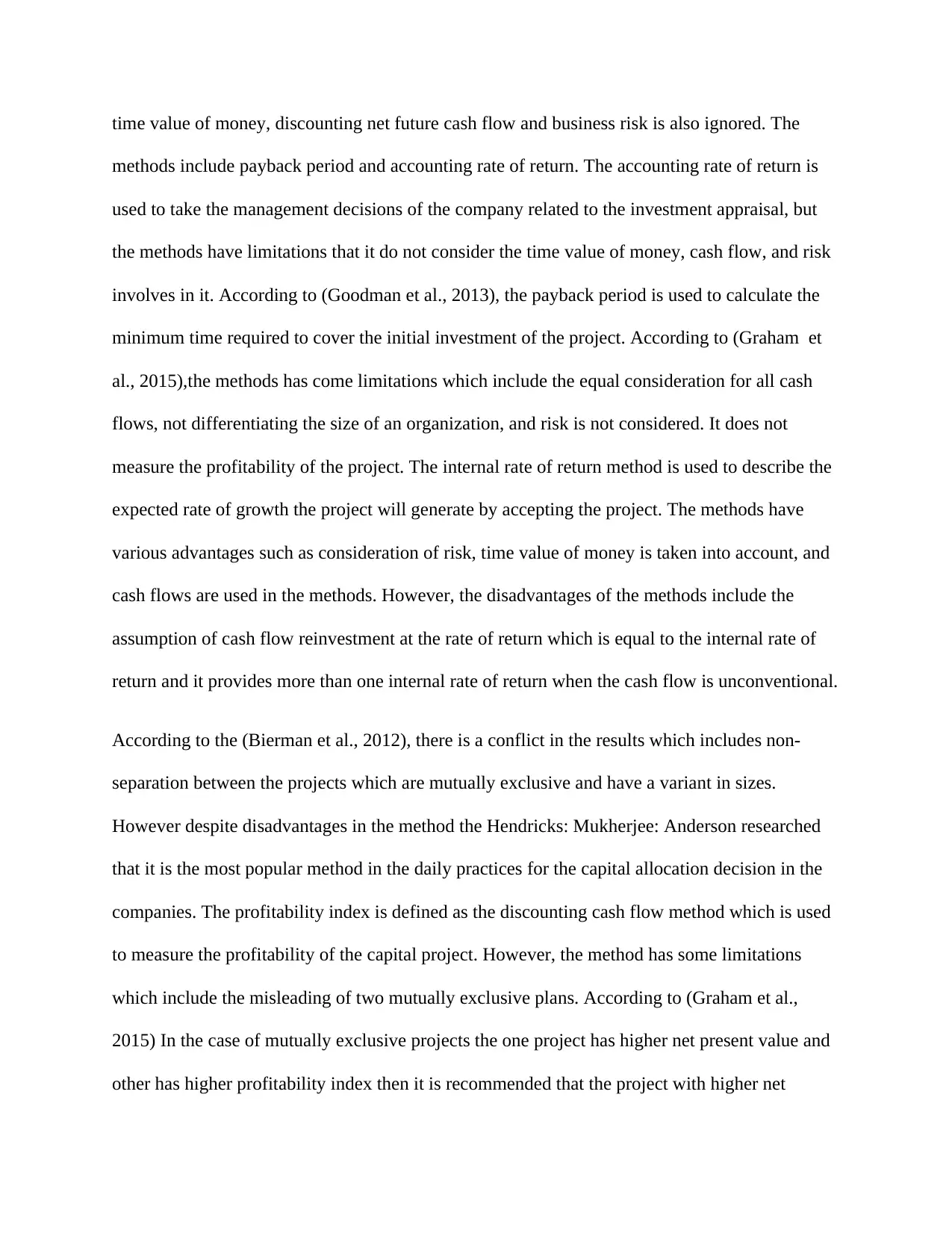
time value of money, discounting net future cash flow and business risk is also ignored. The
methods include payback period and accounting rate of return. The accounting rate of return is
used to take the management decisions of the company related to the investment appraisal, but
the methods have limitations that it do not consider the time value of money, cash flow, and risk
involves in it. According to (Goodman et al., 2013), the payback period is used to calculate the
minimum time required to cover the initial investment of the project. According to (Graham et
al., 2015),the methods has come limitations which include the equal consideration for all cash
flows, not differentiating the size of an organization, and risk is not considered. It does not
measure the profitability of the project. The internal rate of return method is used to describe the
expected rate of growth the project will generate by accepting the project. The methods have
various advantages such as consideration of risk, time value of money is taken into account, and
cash flows are used in the methods. However, the disadvantages of the methods include the
assumption of cash flow reinvestment at the rate of return which is equal to the internal rate of
return and it provides more than one internal rate of return when the cash flow is unconventional.
According to the (Bierman et al., 2012), there is a conflict in the results which includes non-
separation between the projects which are mutually exclusive and have a variant in sizes.
However despite disadvantages in the method the Hendricks: Mukherjee: Anderson researched
that it is the most popular method in the daily practices for the capital allocation decision in the
companies. The profitability index is defined as the discounting cash flow method which is used
to measure the profitability of the capital project. However, the method has some limitations
which include the misleading of two mutually exclusive plans. According to (Graham et al.,
2015) In the case of mutually exclusive projects the one project has higher net present value and
other has higher profitability index then it is recommended that the project with higher net
methods include payback period and accounting rate of return. The accounting rate of return is
used to take the management decisions of the company related to the investment appraisal, but
the methods have limitations that it do not consider the time value of money, cash flow, and risk
involves in it. According to (Goodman et al., 2013), the payback period is used to calculate the
minimum time required to cover the initial investment of the project. According to (Graham et
al., 2015),the methods has come limitations which include the equal consideration for all cash
flows, not differentiating the size of an organization, and risk is not considered. It does not
measure the profitability of the project. The internal rate of return method is used to describe the
expected rate of growth the project will generate by accepting the project. The methods have
various advantages such as consideration of risk, time value of money is taken into account, and
cash flows are used in the methods. However, the disadvantages of the methods include the
assumption of cash flow reinvestment at the rate of return which is equal to the internal rate of
return and it provides more than one internal rate of return when the cash flow is unconventional.
According to the (Bierman et al., 2012), there is a conflict in the results which includes non-
separation between the projects which are mutually exclusive and have a variant in sizes.
However despite disadvantages in the method the Hendricks: Mukherjee: Anderson researched
that it is the most popular method in the daily practices for the capital allocation decision in the
companies. The profitability index is defined as the discounting cash flow method which is used
to measure the profitability of the capital project. However, the method has some limitations
which include the misleading of two mutually exclusive plans. According to (Graham et al.,
2015) In the case of mutually exclusive projects the one project has higher net present value and
other has higher profitability index then it is recommended that the project with higher net
Paraphrase This Document
Need a fresh take? Get an instant paraphrase of this document with our AI Paraphraser
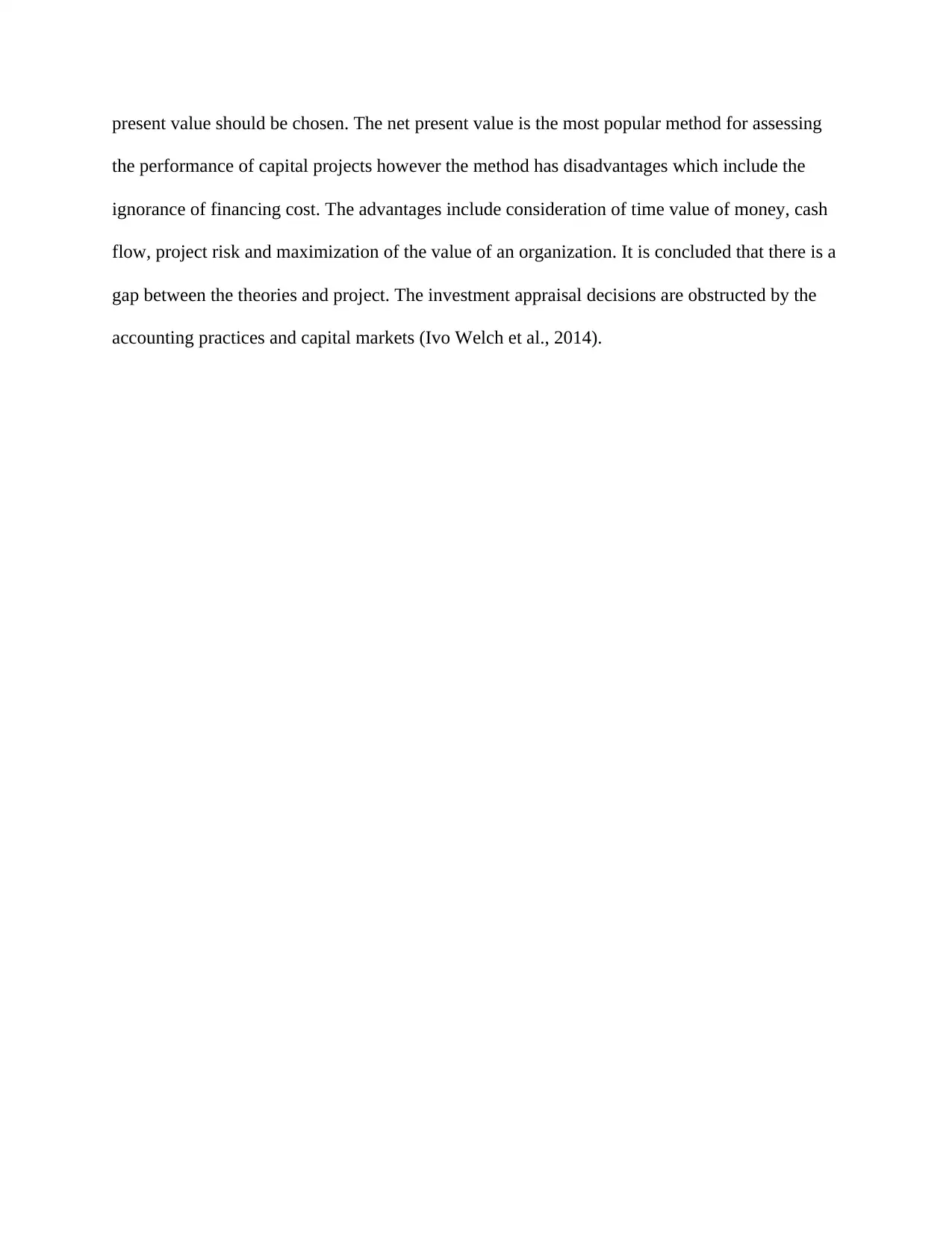
present value should be chosen. The net present value is the most popular method for assessing
the performance of capital projects however the method has disadvantages which include the
ignorance of financing cost. The advantages include consideration of time value of money, cash
flow, project risk and maximization of the value of an organization. It is concluded that there is a
gap between the theories and project. The investment appraisal decisions are obstructed by the
accounting practices and capital markets (Ivo Welch et al., 2014).
the performance of capital projects however the method has disadvantages which include the
ignorance of financing cost. The advantages include consideration of time value of money, cash
flow, project risk and maximization of the value of an organization. It is concluded that there is a
gap between the theories and project. The investment appraisal decisions are obstructed by the
accounting practices and capital markets (Ivo Welch et al., 2014).
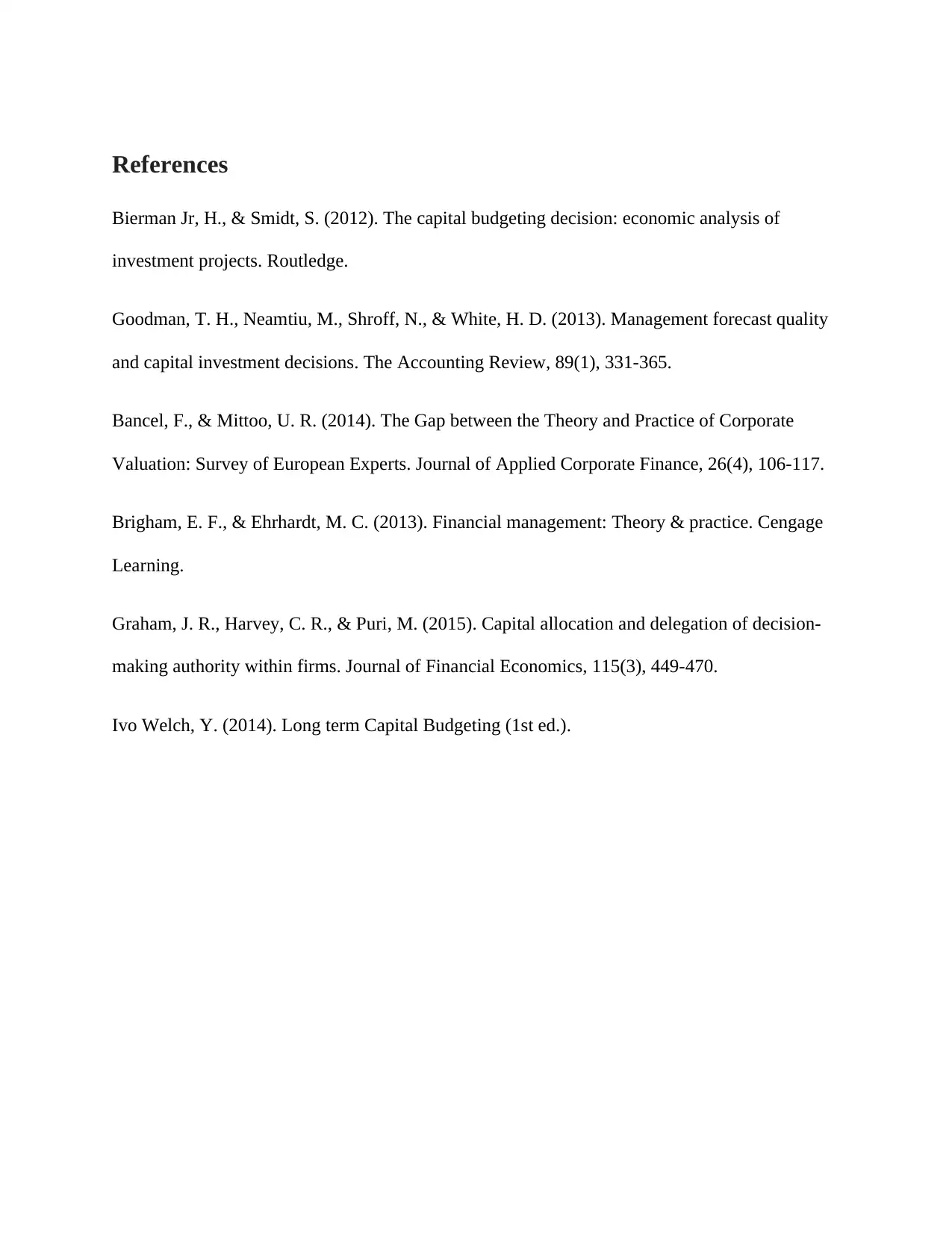
References
Bierman Jr, H., & Smidt, S. (2012). The capital budgeting decision: economic analysis of
investment projects. Routledge.
Goodman, T. H., Neamtiu, M., Shroff, N., & White, H. D. (2013). Management forecast quality
and capital investment decisions. The Accounting Review, 89(1), 331-365.
Bancel, F., & Mittoo, U. R. (2014). The Gap between the Theory and Practice of Corporate
Valuation: Survey of European Experts. Journal of Applied Corporate Finance, 26(4), 106-117.
Brigham, E. F., & Ehrhardt, M. C. (2013). Financial management: Theory & practice. Cengage
Learning.
Graham, J. R., Harvey, C. R., & Puri, M. (2015). Capital allocation and delegation of decision-
making authority within firms. Journal of Financial Economics, 115(3), 449-470.
Ivo Welch, Y. (2014). Long term Capital Budgeting (1st ed.).
Bierman Jr, H., & Smidt, S. (2012). The capital budgeting decision: economic analysis of
investment projects. Routledge.
Goodman, T. H., Neamtiu, M., Shroff, N., & White, H. D. (2013). Management forecast quality
and capital investment decisions. The Accounting Review, 89(1), 331-365.
Bancel, F., & Mittoo, U. R. (2014). The Gap between the Theory and Practice of Corporate
Valuation: Survey of European Experts. Journal of Applied Corporate Finance, 26(4), 106-117.
Brigham, E. F., & Ehrhardt, M. C. (2013). Financial management: Theory & practice. Cengage
Learning.
Graham, J. R., Harvey, C. R., & Puri, M. (2015). Capital allocation and delegation of decision-
making authority within firms. Journal of Financial Economics, 115(3), 449-470.
Ivo Welch, Y. (2014). Long term Capital Budgeting (1st ed.).
⊘ This is a preview!⊘
Do you want full access?
Subscribe today to unlock all pages.

Trusted by 1+ million students worldwide
1 out of 6
Related Documents
Your All-in-One AI-Powered Toolkit for Academic Success.
+13062052269
info@desklib.com
Available 24*7 on WhatsApp / Email
![[object Object]](/_next/static/media/star-bottom.7253800d.svg)
Unlock your academic potential
Copyright © 2020–2025 A2Z Services. All Rights Reserved. Developed and managed by ZUCOL.





